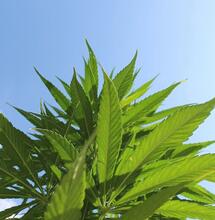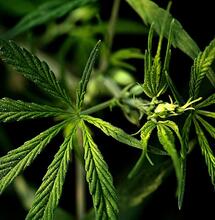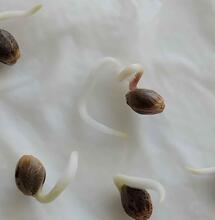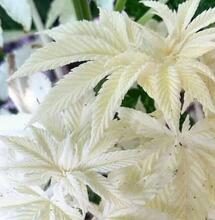Clones and Cloning
_26.jpg)
Many articles have been written about how to cut clones, but not all growers understand the 'why' of the process.
Many articles have been written about how to cut clones, but not all growers understand the 'why' of the process.
The Cannabis seedling growth stage lasts for about two to three weeks, from seed germination to (strong) root set. Once a strong root system is established, foliage growth increases rapidly and seedlings enter the vegetative growth stage. When chlorophyll production is optimal, a vegetative plant will produce as much green leafy foliage and root growth as is physically and genetically possible.
Of course, growing conditions - CO2, soil oxygen levels, nutrients, water and so on - must not be limited and must be in the proper balance to be available for rapid uptake. Properly maintained, some varieties of medical Cannabis will grow from half an inch to two inches per day. A plant stunted for any reason could take weeks to resume normal growth. A severely stunted plant may never fully recover.
Nutrient Deficiencies Weaken Marijuana Plants
A strong, unrestricted root system in a perfect rhizosphere (root zone) that is able to take in all necessary available nutrients is essential to robust growth. Unrestricted vegetative growth is the key to a healthy harvest. A plant's nutrient and water intake changes during the vegetative stage. High levels of nitrogen are needed and potassium, phosphorus, calcium, magnesium, sulfur and trace elements are used at much faster rates. Transpiration occurs at a more rapid rate, requiring more water.
The larger a plant gets and the bigger its root system, the faster the soil will dry out. The key to strong vegetative growth and a heavy harvest is supplying plants with the perfect environment both above and below ground. During vegetative growth, plants need water and often require supplemental fertilizer, as well. Outdoor and greenhouse organic gardeners are able to build organic soil with bulk nutrients and amendments. Indoor gardeners most often need to add supplemental fertilizer. The garden will also need adequate air circulation and ventilation, both day and night. Nutrient deficiencies that start in the first or second week of growth indoors usually show outward signs by the third to fifth week of growth. Nutrient deficiencies that begin during the fourth or fifth week of growth outdoors and in greenhouses show visible outward symptoms during the sixth to eighth week of growth.
Low-level nutrient imbalances take longer to manifest, if ever. Infestations of diseases and pests often flare as nutrient deficiencies progress. Many times, new clones from another garden are already infested with spider mite eggs, powdery mildew or root disease, with few outwardly-visible signs. Always quarantine and dip new clones and seedlings in an organic fungicide/insecticide/miticide before introducing them to the garden. After one to three months of vegetative growth, nutrients have had a chance to build up to toxic levels and plants may show outward signs of deficiencies or excesses. Leaching containers will wash away water-soluble toxic nutrients. Other problems - over-watering, under-watering, poor air circulation and ventilation, etc. - may also occur.
Natural Longevity of Marijuana Plants
Cannabis will continue vegetative growth for a year or longer under an eighteen-hour photoperiod and a temperate climate. However, sooner or later a genetic maximum is reached, causing Cannabis to degenerate. Indica and indica-dominant varieties suffering stress from cold, wintry conditions tend to flower regardless of hours of light, often producing more resin on stunted plants. Indoors and in greenhouses, growth stages can be controlled with the light/dark cycle (photoperiod), which is the main stimulus to induce flowering. Give plants a twelve-hour day and twelve-hour night light schedule to induce flowering.
Give plants up to eight hours of darkness and sixteen to twenty-four hours of light to retain vegetative growth. Controlling the photoperiod allows indoor and greenhouse horticulturists to control vegetative and flowering cycles. Outdoor gardeners work with Mother Nature and harvest after long nights and short days in spring and autumn. Once a plant's sex is determined, it can become a mother, clone or breeding male and can be harvested or even rejuvenated. Note: Plants show early male or female 'pre-flowers' at about the fourth week of vegetative growth. Transplanting, pruning, bending, and trellising are all initiated when plants are in the vegetative growth stage.
Transplanting Cannabis Clones
When plants have outgrown their containers, they must be transplanted in order to continue rapid growth. Inhibited, cramped root systems grow sickly, stunted plants. Signs of root-bound plants include slow, weak growth. Severely root-bound plants tend to grow straight up, with branches that painstakingly stretch beyond the sides of the pot. By the time you see these symptoms, the plant is already root-bound. To check roots, remove a plant from its pot to see if roots are deeply matted on the bottom or circling the sides of the pot.
When growing short plants that can be watered daily and reach full maturity in seventy to ninety days from clones or seedlings, there is little need for containers larger than approximately three to five gallons (11.4 to 19 L). Larger plants and mother plants will need a large pot if they are kept for more than three months. Outdoors and in greenhouses, plants can grow much larger than indoors. Containers should be as big as possible to accommodate a large root mass. Big plants that produce ten pounds (4.5 kilos) of medical Cannabis buds can be grown in 200- to 500-gallon (757 to 1,893 L) containers.



